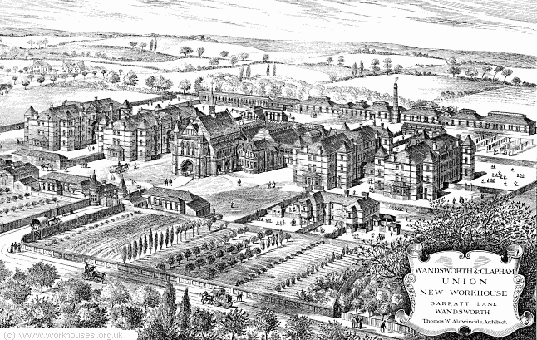In 1886 a new workhouse was built to imprison the poor of the Wandsworth & Clapham Poor Law Union, in Swaffield Road, off Garratt Lane, Wandsworth, now part of Southwest London, but then in open countryside.
Under the 1834 Poor Law Amendment Act, the Boards of Guardians were obliged by law to ‘help’ local poor folk unable to support themselves either with ‘outdoor relief’ (a minimum dole) or with ‘indoor relief’ – accommodation and work in the workhouse. In practice the workhouses were made oppressive, cruel and humiliating, to dissuade as many people as possible from applying. Families were split up, food was pitiable and inedible, long hours of grinding work were imposed under often sadistic overseers.
The Poor Law had been brought in because of a widespread concern among authorities and the upper and middle classes that the cost of welfare was spiralling out of control, and a convinced belief that people would rather seek an easy life, ie claiming relief, than work. The Act was therefore designed to make claiming relief so painful, degrading and inadequate that people would rather take any work instead.
If this sounds in any way familiar… There are many parallels between the way the power-that-be in the 1930s were viewing the poor, and discussing the ‘problem’ of the cost of welfare, and how this debate in recent years has also been framed. For an interesting exhibition, put together by the Anarchist Time Travellers, which illustrates the links between the two, see This Way to 1834.
Although there were riots in northern England when the Act was introduced, and a sprinkling of resistance by the working people forced into workhouses throughout the 19th century, all in all, the system worked quite well from the perspective of the rich. Fear and hatred of the workhouses (which became known as ‘bastilles’ for the notorious french prison) grew so that people would rather starve outside than in, and the shame of having to apply to enter became internalised deeply into working class consciousness.
However, in the sharp recession following World War 1, hundreds of thousands of working people were thrown into unemployment, including many who had taken part in strikes and industrial unrest before and during the war. As thousands of soldiers were demobilised from the army, and the war economy was suddenly wound down, struggles over rights to relief, and facilities for the unemployed, broke out all over the UK. Initially organised through local committees of the unemployed, most federated by 1921 into the National Unemployed Workers Committee Movement (usually known as the NUWM), which was to be the main vehicle for unemployed organising for 20 years.
As an example of the local struggles which gave birth to/characterized the early years of the NUWM: in July 1921, the unemployed in Wandsworth and Battersea were told by the local Board of Guardians they would not receive any outdoor relief, but would all have to apply to workhouse. The Battersea & Wandsworth Unemployed Committee decided that the best was to deal with this was to swamp the Workhouse. 1000 people all applied for tickets to enter, at the same time! Then, in late July, 700 unemployed people, including whole families, took over the building, having marched from Clapham Junction with a bagpiper at their head! (Interestingly, this became a sort of local tradition: I remember in the early 1990s, anti-poll tax and anti-cuts demos in Wandsworth used to march on the town hall with Alasdair from metal-bashing band Test Dept playing his pipes at the head of the procession).
Having occupied the workhouse, the unemployed refused to recognise the authority of the Poor Law officers, and refused to accept the measly food and harsh conditions. As there had been 900 people already in residence in the workhouse, the institution descended into chaos. A massive solidarity demonstration took place outside in support of the occupation. “From the hall of the workhouse speeches were delivered to the demonstrators outside. Then, to the amazement and jubilation of the demonstrators, about 9 o’clock just as it was getting dusk, we saw the red flag run up on a flag mast over the workhouse.” Eventually the embattled Poor Law Guardians withdrew their order and restored outdoor relief on 27th July.
For more on this occupation, the unemployed struggles of the 1920s-40s, it’s worth reading Unemployed Struggles 1919-36, by Wal Hannington, and We Refuse to Starve in Silence: A History of the National Unemployed Workers’ Movement, by Richard Croucher.
@@@@@@@@@@@@@@@@@@@@@@@@@@@@@@@
An entry in the 2016 London Rebel History Calendar – check it out online

Leave a comment